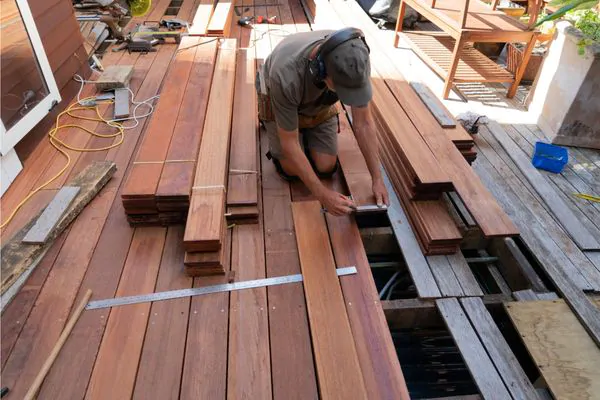Maintaining a travertine pool deck can be challenging. Over time, dirt, stains, and grime can dull its natural beauty and make cleaning seem overwhelming.
Travertine is a popular choice for pool areas because of its durability and elegance. Understanding how to clean travertine pool deck properly helps preserve its appearance and extend its lifespan.
This article provides expert tips on effective cleaning techniques, sealing methods, and stain removal to keep your travertine pool deck looking pristine. Keep your pool area stunning with these essential maintenance strategies.
Key Takeaways
- Use the Right Cleaners
Clean with mild dish soap or special stone cleaners like Simple Green Oxy Solve. Avoid harsh chemicals such as bleach and vinegar. - Gentle Scrubbing
Use a soft brush to scrub the travertine. This removes dirt and grime without scratching the surface. - Thorough Rinsing
Rinse the deck well with a hose to remove all cleaning residue. This helps keep the travertine looking fresh. - Regular Resealing
Apply a natural stone sealer every year. This protects the travertine from stains and water damage. - Handle Stains Carefully
Use a paste of baking soda and water to treat stains. Avoid using bleach or acidic cleaners to prevent damage.
Essential Cleaning Techniques for Travertine Pool Decks
Using the right cleaners and tools is vital for cleaning travertine pool decks effectively. Proper techniques help preserve the stone’s natural beauty and prevent damage over time.
Gentle scrubbing with appropriate cleaners
Use a mild dish soap solution to clean your travertine pavers regularly. Avoid harsh chemicals like bleach and ammonia, which can damage the natural stone surface. Opt for commercial cleaners such as Simple Green Oxy Solve, Black Diamond Stoneworks, or Granite Gold Outdoor Cleaner.
Apply the cleaner with a soft brush and gently scrub the travertine tile to remove dirt and grime without scratching the pavers.
Rinse thoroughly with water to prevent residue buildup. Proper rinsing helps maintain the beauty of your travertine pool deck. Using a hose ensures all cleaner is washed away, keeping your patio looking fresh.
Using the right cleaner preserves the beauty and longevity of your travertine tiles.
Proper rinsing to prevent residue buildup
Proper rinsing with a hose removes cleaning agents from travertine pool decks. This step prevents residue buildup that can harm the stone’s surface. After using a pressure washer, ensure thorough rinsing to clear all cleaning solutions.
Rinsing also helps remove mildew, especially when using peroxide-based cleaners. Incorporate rinsing into a 15-minute maintenance strategy to keep travertine pavers clean and lasting.
After poultice treatments, rinse the area well to eliminate leftover chemicals. Using the right stone cleaner made for natural stone pavers aids in maintaining travertine. Avoid acidic cleaners like vinegar, which can damage porous travertine.
Regular rinsing with a hose helps prevent stains from spills of coffee or wine. This practice ensures your travertine pool deck stays beautiful and free from residue.
Next, explore advanced maintenance tips to further protect your deck.
Advanced Maintenance Tips
Regularly resealing your travertine pavers provides lasting protection against weather and wear. Effectively removing stubborn stains and using the right pressure washing methods help maintain the beauty of your pool deck.
Resealing techniques for long-term protection
Resealing your travertine pool deck ensures long-term protection. Use an exterior-grade natural stone sealer for best results. First, clean the travertine pavers thoroughly. Allow them to dry for 24 hours before applying the sealant.
Evenly spread the sealer to prevent stains and water damage.
Check the seal by placing small beads of water on the stone’s surface. If the water stays on top, resealing is effective. For stubborn stains, make a poultice with baking soda and a natural stone cleaner.
Avoid using acidic cleaners like vinegar and bleach. Regular resealing helps maintain travertine and keeps your pool deck looking beautiful.
Addressing stains and pressure washing considerations
Tough stains like oil or organic spots can mar your travertine pool deck. Use baking soda mixed with water to make a paste. Apply the paste to the stain and let it sit for a few minutes.
Scrub gently with a soft brush to lift the stain. For stubborn marks, try specialized stain removers designed for travertine. Always test the cleaner in an inconspicuous area first to ensure it won’t damage the stone.
Avoid using bleach or harsh chemicals as they can etch the surface and cause permanent damage.
Pressure washing helps keep your travertine clean without harming it. Use a pressure washer with low settings to avoid scratching the surface. Hold the nozzle at a 45-degree angle and maintain a steady distance from the deck.
Rinse thoroughly to remove any residue and prevent buildup. Regular pressure washing removes dirt and debris, making maintenance easier. If stains persist after washing, consider consulting a professional for deeper cleaning solutions.
Proper pressure washing extends the life of your travertine pool deck and keeps it looking beautiful.
How to Refinish Your Pool Deck
Refinishing your travertine pool deck keeps it looking great for years. Follow these steps to refinish your pool deck effectively.
- Clean the Travertine Surface
- Sweep the deck with a broom to remove dirt and debris.
- Use a hose to wash away loose particles.
- Apply a cleaner made for travertine tile and scrub gently.
- Repair Any Damage
- Check for cracks or chips on the travertine patio.
- Use a travertine-safe filler to fix small damages.
- Let the repairs dry completely before proceeding.
- Remove Old Sealant
- Scrape off any old seal hunting from the deck surface.
- Rinse thoroughly to ensure no residue remains.
- Avoid using harsh chemical substances that can damage travertine.
- Apply a New Sealant
- Choose a high-quality sealant recommended for travertine pavers.
- Follow the manufacturer’s instructions for application.
- Spread the sealant evenly using a broom or applicator.
- Allow to Dry Properly
- Let the sealant cure for the time specified by the manufacturer.
- Protect the deck from heavy use until the sealant is fully dry.
- Regular maintenance after sealing will help the refinished deck last a long time.
Refinishing your travertine deck enhances its beauty and protects it from damage. Use these expert tips to keep your pool deck stunning all year round.
Conclusion
Maintaining your travertine pool deck keeps it looking great and lasting longer. Regular cleaning removes dirt and stops mold from growing. Resealing protects the stone from stains and water damage.
Fixing small problems early can prevent bigger repairs later. Use these expert tips to ensure your pool deck stays beautiful and strong.
FAQs
1. How do I clean travertine pavers effectively?
To clean travertine pavers, use a mild solution of sodium bicarbonate and water. Avoid using bleach or harsh chemicals. Gently scrub the surface with a soft brush and rinse with a hose. For tougher stains, apply scouring powder carefully to prevent damaging the travertine’s porous surface.
2. What is the best solution for cleaning travertine tile?
The best solution for cleaning travertine tile is a mixture of warm water and a pH-neutral cleaner. Avoid acidic or alkaline cleaners like vinegar or bleach. Apply the solution with a soft mop or cloth, then rinse thoroughly to maintain travertine’s natural beauty and prevent surface damage.
3. How often should I perform pool deck maintenance for travertine?
Perform pool deck maintenance for travertine regularly, ideally once a week. This includes sweeping to remove sand and debris, rinsing with a hose to eliminate organic stains, and inspecting for mold or grime. Consistent maintenance helps keep your travertine pool deck clean and extends its lifespan.
4. Can pressure washing damage travertine pavers?
Yes, pressure washing travertine pavers with high pressure can damage the surface. Use a low-pressure setting to avoid etching or weakening the travertine. It is safer to use a gentle hose spray or a soft brush with appropriate cleaning solutions to maintain the integrity of your travertine pool deck.
5. What are the common stains on travertine and how can I remove them?
Common stains on travertine include organic stains from leaves and food, as well as permanent stains from oil or chemicals. To remove organic stains, use a solution of warm water and mild detergent. For tougher stains, apply a poultice made from baking soda and water. Always follow the instructions carefully to prevent damage to the travertine’s surface.
6. Do I need to use specific products to maintain travertine?
Yes, use products specifically designed for natural stone surfaces. Avoid bleach and acidic cleaners, which can harm travertine. Instead, opt for pH-neutral cleaners and scouring powders that are safe for travertine. Regular use of appropriate maintenance products helps preserve the beauty and longevity of your travertine pool deck.









